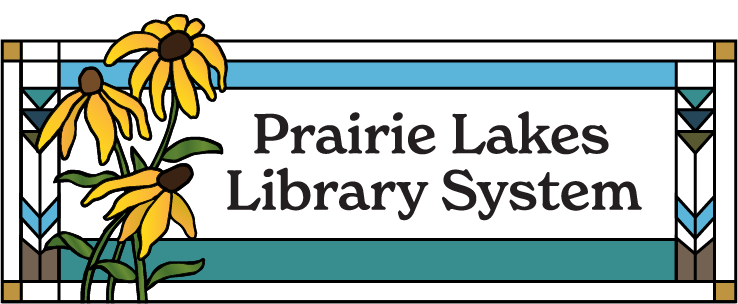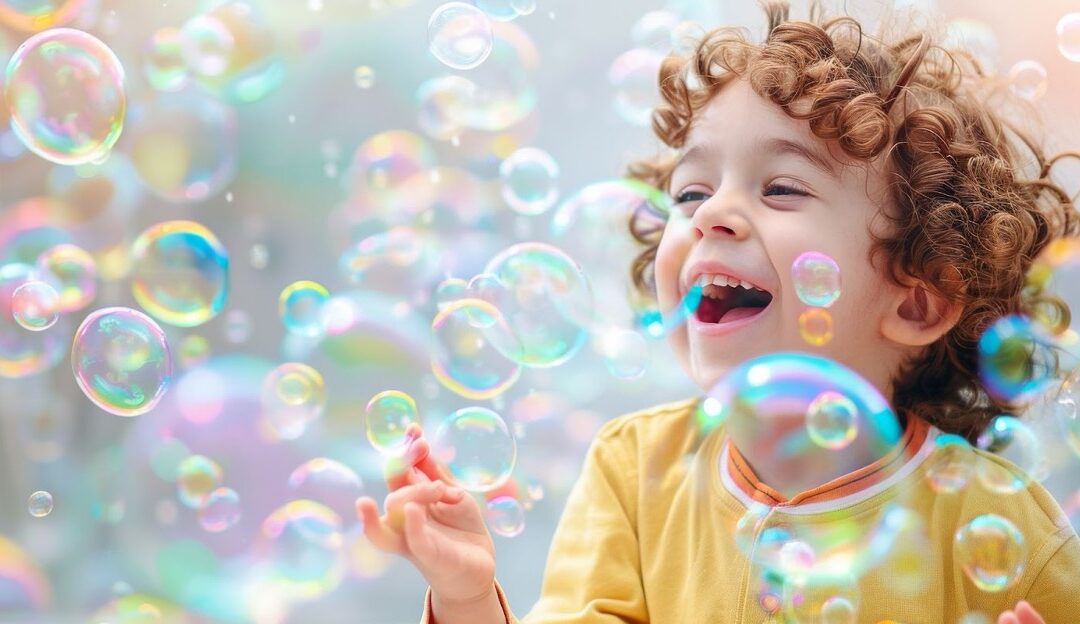Bubbles are a fantastic sensory experience with some much learning and experimenting involved. Regardless of age or ability, bubbles create a sense of magic and wonder and will create smiles all around.
Inclusivity statement: Library programming is designed to be fully inclusive. Age limits may be implemented in certain programs to ensure that program content fosters appropriate developmental markers.
Accessibility:
- Have paper towels available for kids who don’t like to feel wet.
- Provide no-spill bubble tumblers for kids who don’t want to get wet.
- Giant bubble wands are lightweight, so they’re easier for patrons of all abilities to lift.
Mode: Facilitated
Staff Energy: High
Ages: 3-8
Cost: Low
Length: 60 min.
Ideal Attendance: 10+
STEAM Practices:
✓ Science (chemistry)
✓ Art
Tags: science, bubbles, art, preschool, elementary, outdoors, sensory friendly
Credit: Kate Davis
Supplies:
(Commonly on-hand supplies are not included in cost breakdown.)
- Multiple bubble wands ($3.49/20ct)
- Bubble wand and solution (can be whatever size you want, but you’ll need a smaller lid for the last experiment)
- Clear dish soap ($2.98)
- Giant bubble solution ($15.99/6pk)
- Giant bubble wands ($24.98/8)
- White paper
- Washable paint
- Paper cups
- Stirring sticks (popsicle sticks)
- Pointy scissors
- Skewers, toothpicks, chopsticks, etc.
- Tray/bucket
- Bubble machine (optional)
Instructions: Activity 1: Bubble Painting
Mix a squirt of paint and a half cup of bubble solution in a cup or tray. Do this for as many colors as you’d like to provide. Put several bubble wands into each color.
Provide each child with paper and have a stack more handy, along with crayons/pencils for their to write their names on their art work.
Have children blow bubbles on to the paper. Encourage patterns, color placement, blowing close to the paper and blowing farther from the paper.
Instructions: Activity 2: Giant Bubbles
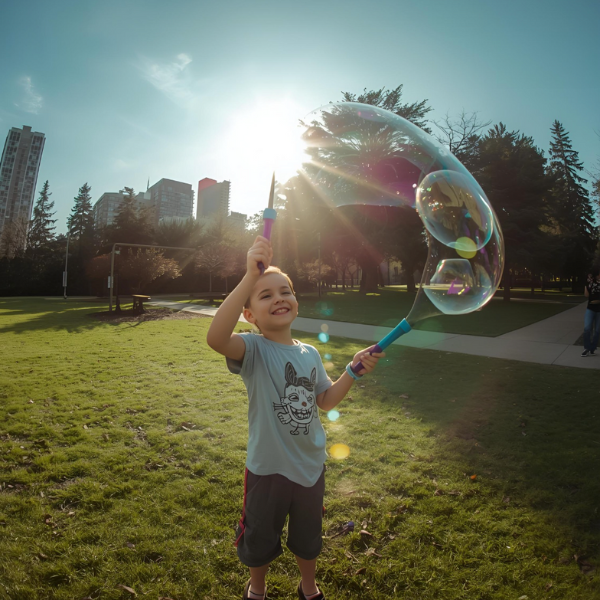
1. Have kids dip giant wands into tray and create giant bubbles. Can they step through the bubbles? Or make a giant bubble around a friend?
Instructions: Activity 2: DIY Bubble Wands
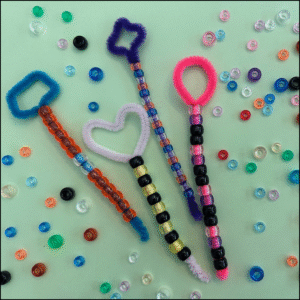
Bend one end of the pipe cleaner into a loop, twisting the end around to secure it in place. Bend the loop into a shape, like a heart or a square.
Slide pony beads onto the handle.
Loop the handle end of the pipe cleaner through the lowest pony bead to secure.
Instructions: Activity 4: Bubble Science in Action
Science can be intimidating to some of us, so here is a script to work from. Do the actions in italics while using the non-italics info as your script for explaining the science of bubbles.
If you have a bubble machine, set it to go for a few seconds, then turn it off so it’s not a distraction. If you don’t have one, blow a bunch of bubbles before you start talking.
A bubble is just air wrapped in soap film. Soap film is made from soap and water (or other liquid). The outside and inside surfaces of a bubble consist of soap molecules. A thin layer of water lies between the two layers of soap molecules, sort of like a water sandwich with soap molecules for bread. They work together to hold air inside.
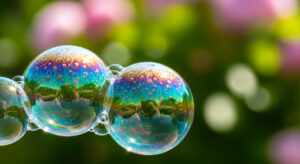
Why is a bubble round? Bubbles can stretch and become all kinds of crazy looking shapes. But if you seal a bubble by flipping it off your wand, the tension in the bubble skin shrinks to the smallest possible shape for the volume of air it contains. That’s why even if it had a goofy shape before you sealed it, once sealed shut, the bubble will shrink into a sphere shape. Compared to any other shape, a sphere has the smallest surface area for the amount of volume.
Blow several bubbles and have the students blow and fan them to keep them from landing. The object here is to watch them pop without obvious interference. And it’s a bit of fun for everyone. (Can use bubble machine.)
Why do bubbles pop? Other than being poked or landing on something sharp, bubbles pop when the water between the soap film surfaces evaporates. To note, when it’s cold, those molecules take longer to leave. If you blow a bubble on a calm winter day, a bubble can even freeze and last for several minutes before it wisps away.
Also, the colder the outside temperature is, the higher a bubble might fly. That’s because the warm air from your breath is lighter than cold air.
Blow more bubbles and ask a few students to study them close-up. What do they see? Is a bubble really transparent, or do bubbles have colors? Can they see their faces in the bubbles? (Can use bubble machine.)
A bubble gets its color from light waves reflecting between the soap film’s outer and inner surfaces. The distance between the layers gets smaller as the water evaporates, making the colors change. Bubbles can also reflect what’s around them, like the faces peering at them.
Blow several bubbles with a straw so that you have three of them stuck together – this might take practice!
Why do bubbles stick together? Since a bubble tends to minimize its surface area, bubbles will join together to share one common wall. Three bubbles will meet at the center, always at an angle of 120 degrees.
This is not as easy to set up, but not that difficult and a very cool experiment: use two sheets of clear plastic that are about a half inch apart. You could put one sheet on a table and prop up the second with thin blocks. Soak the sheets in a bubble solution, place them, and then blow bubbles between them.
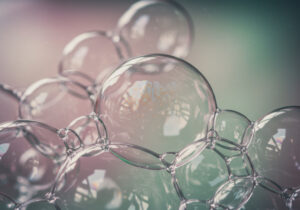
When bubbles are about the same size, they form perfect hexagons. Bees do the same thing when they build a beehive. Bees, like bubbles, are also very efficient with their spaces. They use the minimum amount of wax to create their spaces.
Your Grand Finale: Set the lid of the bubble container on a table and fill it with bubble solution. Dip a straw into the container so it is moistened by the solution, and blow a bubble on the lid. Then draw out the straw. Magic! Next, dip the pointed ends of a pair of scissors in the solution. Poke them through the wall of your bubble. Let the kids try poking other stuff that has been moistened in the solution, even their fingers. You can then poke your straw back inside the bubble and blow another bubble!
Why didn’t the bubble pop? The bubble just wraps itself around anything that is wet, filling in the hole that would have been made.
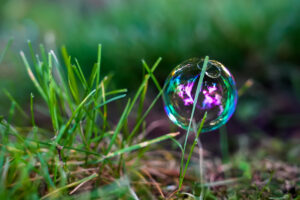
Staff Know-How
Planning, Set Up & Facilitation
Bubble Painting Prep
- Just before the program: create paint solution with a 3-1-1 ratio when mixing (3 parts paint, 1 part water, 1 part dish soap). Use as little water as possible so that paint color will keep its concentrations.
Giant Bubbles Prep
- Mix solution in tray.
Bubble Wands Prep
- Put pony beads in bowls.
- Spread out pipe cleaners on table so kids can easily pick their favorite colors.
Bubble Science in Action Prep
- Prep your bubble machine or manual bubbles.
- Lay out straws, pointy scissors, skewers, toothpicks, and chopsticks so that they’re close but not in reach of little ones.
Pro-Tips
- Have on at when kids are arriving and then the last 5 minutes of the program. Turn on some music to make it extra fun!
- Don’t be afraid to read the science explanations. You don’t have to memorize anything!
- Younger kids will need assistance with making the DIY bubble wands.
Marketing & Promo
Book Suggestions
Bubble-Palooza Book List (4.25 x 11 in)
Resources are availabe in the SHARE catalog as of May 2025.
Bubble Trouble (Mahy, Margaret)
Bubbles (Chase, Kit)
Bubbles (Clanton, Ben)
Bubbles… Up!(Davies, Jacqueline)
Bubbles, Bubbles (Appelt, Kathi)
Bubbles, Bubbles (Sesame Street)
Bubbles Bubbles Everywhere (Angues, Lisa)
Bubble’s Ocean Friends (Roth, Megan)
You Can’t Kiss a Bubble (Wyle, Karen A.)
Bath Time (Spinelli, Eileen)
Bird Bath (Antony, Steve)
Bath Time (Gerver, Jane E.)
Reusability
Bubbles and bubble machines are perfect accompaniment to most children’s activities as well as outreach events.
If you have a Glowforge, dish soap is a great protectant on acrylic to prevent the laser from creating an echo scratch.
